
Vietnam Journal
of Agricultural
Sciences
ISSN 2588-1299
VJAS 2018; 1(3): 220-229
https://doi.org/10.31817/vjas.2018.1.3.03
http://vjas.vnua.edu.vn/
220
Received: April 20, 2018
Accepted: December 13, 2018
Correspondence to
nttthuycntp@vnua.edu.vn
ORCID
Nguyen Thi Thanh Thuy
http://orcid.org/0000-0003-2896-
2933
Isolation and Screening of Histamine-
Producing Bacteria from the First Six
Months of the Cat Hai Fish Sauce
Fermentation Process
Dang Thao Yen Linh, Tran Thi Thu Hang, Nguyen Thi
Lam Doan, Nguyen Hoang Anh and Nguyen Thi Thanh Thuy
Faculty of Food Science and Technology, Vietnam National University of Agriculture,
Hanoi 131000, Vietnam
Abstract
Histamine is considered to be a hazard in fish sauce, and histamine
poisoning usually causes symptoms such as a runny nose, asthma
(bronchospasm), urticaria, rash, itching, swelling (eyelids, puffy
lips), inflammation, and redness of the conjunctiva. In this study,
Cat Hai fish sauce, one of the major traditional fish sauce
manufacturers in Vietnam, was used to investigate the variation in
histamine content during the fermentation process and to isolate
histamine-producing bacteria. Six Dich Chuop samples
corresponding to the first sixth months from the beginning of
fermentation were collected for these purposes. The results showed
that the content of histamine in the six samples corresponding to the
first six months from the beginning of fermentation tended to
increase during fermentation, reaching the highest rate of 604.85
ppm in the fifth month. A total of 50 isolates were collected from
TSA medium and used for screening histamine-producing bacteria
on HBI medium. Among these bacteria, four isolates (CH2.4,
CH3.3, CH4.4, and CH5.1) were capable of producing histamine,
and the highest producing isolate, CH5.1 (from 5th month), was
identified as Tetragenococus halophilus. Furthermore, this
Tetragenococus halophilus was determined to have the highest
histamine production in HBE supplemented with 1% histidine at
50°C, pH 6.0, and 25% NaCl.
Keywords
Cat Hai fish sauce, histamine, histamine-producing bacteria,
fermentation process
Introduction
Fish sauce is a protein solution that mainly consists of amino
acids, and is used as a spice for cooking, sauce, or food in the daily
meal (Fukami et al., 2004). Vietnam has about 2,800 fish sauce

Dang Thao Yen Linh et al. (2018)
http://vjas.vnua.edu.vn/
221
production facilities, producing more than 215
million liters per year, worth over VND 4,800
billion (Department of Agriculture, Forestry and
Fisheries, 2014). However, Vietnam's fish sauce
exports account for only about 3-5% of the
production (Vietnam Online Quality, 2016). The
main cause of the current low export volume is
that there are no well-established brands of
Vietnamese fish sauce overseas. In addition,
another important issue is that traditional
Vietnamese fish sauce often encounters
technical barriers with some international
quality standards. One of the important quality
targets is histamine.
The traditional fermented fish sauce
production process consists of two major stages,
namely hydrolysis (primary fermentation) and
odorization (secondary fermentation). In the
primary fermentation stage, fish protein is
hydrolyzed into amino acids. Fermentation
helps to complete the hydrolysis process to form
the flavor of the fish sauce. The traditional fish
sauce production in each locality has different
stages, but it follows a strict rule of thumb and
usually lasts from 12 to 18 months.
Despite having a high nutritional value, the
presence of biological amines in the fish sauce
at high levels, particularly histamine, is a risk
to human health (Askar et al., 1993; Tsai et al.,
2007; Zaman et al., 2010). Histamine is formed
by the separation of the α-carboxyl group from
the histidine amino acid. Histidine is one of the
non-essential amino acids that the human body
does not synthesize itself, and which must be
obtained from food. Histidine is often found in
foods such as fish, meat, eggs, and dairy
products (Wickham, 2011). Histamine
poisoning usually causes symptoms such as a
runny nose, asthma (bronchospasm), urticaria,
rash, itching, swelling (eyelids, puffy lips),
inflammation, and redness of the conjunctiva
(Mahidol et al., 2003). According to Codex
302-2011, histamine is considered to be a
hazard in fish sauce and the contents of this
compound must not exceed 400 ppm.
However, traditional Vietnamese sauce with
histamine content ranging from 700-3000 ppm
was reported (Union of Science and
Technology in Binh Thuan, 2013). This leads
to a risk of unsafe use of fish sauce due to
histamine poisoning.
There are three main methods of reducing
histamine levels in fish sauce: physical,
chemical, and microbiological methods.
However, the physical and chemical methods
have the disadvantages of high cost, difficulty in
application, and unsafe methods for the users.
Therefore, microbiological methods with the
advantages such as ease of application, lower
price, and safety become feasible methods to
control the amount of histamine in fish sauce,
but to apply these methods requires more
research.
The aim of this research was to determine
the changes in histamine content in Dich Chuop
Cat Hai fish sauce during the first six months of
fermentation and isolate and screen histamine-
producing bacteria from its product. This data
provide the premise for further research to
inhibit histamine-producing bacteria in fish
sauce from which to improve the quality and
serve the increasing demand of consumers.
Materials and Methods
Materials
Samples collection
Cat Hai fish sauce is produced by the
stirring method, and the fermentation time is
one year. In this study, we sampled fish sauce in
the first 6 months of fermentation to isolate
histamine-producing bacteria.
Dich Chuop, fish materials (usually salted
fish) decomposed through fermentation to make
fish sauce, was taken from the Cat Hai Seafood
Processing Service Joint Stock Company - Cat
Hai Town - Hai Phong province. The samples
were collected from the raw materials during the
first month to the sixth month, and sampling
occurred every month from the same tank. Dich
Chuop samples were stored at 4-6°C in plastic
bottles.
Media use
Three types of media were used in this
present study as follows: HBI - Medium for
screening histamine-producing bacteria (g L-1):

Isolation and screening of histamine-producing bacteria from the first six months of the Cat Hai fish sauce fermentation process
222
Vietnam Journal of Agricultural Sciences
5 g trypton; 5 g yeast extract; 10 g histidine;
0.06 g bromoresol purple, 1 g CaCO3; 25 g
agar; 200 g NaCl; pH 6.47 (Nga, 2016); TSA -
Medium (Trypticase Soy Agar Histidine) for
isolation of and conservation of the bacteria (g
L-1): 15 g tryptone, 5 g soy peptone; 5 g
sodium chloride, 12 g agar No. 2; pH 7.3 ±
0.2 (Lab, United Kingdom) with 20% NaCl;
and HEB - Medium for culturing and
determining the bacteria’s ability to produce
histamine (g L-1): 5 g tryptone; 2.5 g K2HPO4;
10 g L-histidine; 200 g NaCl; pH 6.0 (Nga,
2016).
Methods
The flow diagram of the general
experiments is as follows:
Sampling
Samples were taken according to TCVN 5676-
90 from different points in the tank (four corners of
the tank, on the surface, at the bottom, and in the
middle of the tank as shown in Figure 1).
Firstly, 1% of the Dich Chuop volume was
taken from different tanks each month of
fermentation before being mixed together in a
container, which was called the intermediate
sample. Finally, 2000 mL of Dich Chuop was
taken from the container of intermediate sample
to be used for further analysis.
The samples were then stored at 4-6oC for 7
days for the analysis of histamine content and
isolation of bacteria which are capable of
producing histamine in different stages of
fermented fish sauce.
Figure 1
. Diagram of sampling methods following TCVN 5676-90
Analysis of
histamine content
Isolation of histamine
producing bacteria
Dich Chuop samples
Screening
Characterization
of histamine-
producing activity
Identification of
selected strains
Intermediate
sample
2000 mL
Sample
for
analysis
Stored at 4-6
o
C
Analysis in 7 days
……

Dang Thao Yen Linh et al. (2018)
http://vjas.vnua.edu.vn/
223
Determination of histamine content by HPLC
The equipment used for the determination
of histamine content in the samples were a
separation system including an HPLC (Agilent)
with detection by fluorescence
spectrophotometer, and XDB C18 column
(Agilent) with an inside diameter of 4.6 mm and
length of 250.0 mm.
The protocol methods followed Yoshida et
al. (2012) and TCVN 8352:2010 with several
modifications. In short, 100 µL samples were
homogenized in 900 µL Methanol: H2O (75:25)
and then centrifuged for 10 min at 6000 g. After
2 µL of supernatant was collected, 4 µL solution
of Na2B4O7 (pH 10.0), 4 µL OPA (ortho-
phthalaldehyde), and 10 µL KH2PO4 were
added.
The chromatographic conditions were as
follows: A phase (KH2PO4 0.01M, pH 4.0): 75
and B phase (Acetonitrile 100%): 25. The flow
rate was 1 mL min-1, and detection was at 230
nm and 450 nm. The column temperature was
40ºC and the injection load was 5 µL. In terms
of the scope of application, the LOD (Limit of
Detection) was 5 ppm and the LOQ (Limit of
Quantification) was 15 ppm.
Isolation of bacteria from samples
From the 06 samples taken at different
fermentation stages, bacteria isolation was
carried out on TSA medium, at pH 7.2, and with
a concentration of 20% NaCl. Descriptions of
bacterial colonies were based on the color, size,
surface structure, and outer edge of colonies.
Screening histamine-producing bacteria
All bacteria from the previous experiment
were cultured on HBI medium to determine the
histamine producing bacteria. If the colonies
grown on HBI medium had a purple color, this
indicated that the particular bacteria could
decarboxylase amino acids (Hsien et al., 2010).
Identification of the selected strains
Identification of the bacteria followed the
methods of Marc et al. (2003) and Filipe et al.
(2008) with several modifications. The strains
were selected based on maximum enzyme
activity and identified based on the
morphological observations and the comparison
of 16S rDNA fragments.
As part of the morphological tests, Gram
staining, colony size, shape of bacteria, and
bacteria mobility were performed. Sequence
analysis of 16S rDNA was as follows. DNA was
extracted and purified according to the CTAB
method (the current protocol for the isolation of
DNA in molecular biology) and purification
was determined by spectrophotometrically
measurements at the ratio of A260/A280. The
values should be higher than 1.8 for further PCR
amplification. The 16S rDNA gene fragments
were amplified using universal primers,
including forward primer 27F (5´-
AGAGTTTGATCCTGGCTCAG - 3’) and
reverse primer 1492R (5΄-
GGTTACCTTGTTACGACTT - 3’). PCR was
performed under the following conditions:
initial denaturation at 94°C for 5 min; 30 cycles
of denaturation at 94°C for 45 sec, annealing at
55°C for 45 sec, extension at 72°C for 90 sec,
and a final extension at 72°C for 5 min. The
DNA sequences were then analyzed and aligned
using BLAST.
The effects of several factors on the histamine
production of the isolated strain
The strain which had the highest histamine
producing ability of previous experiment was
used in this experiment.
Effect of table salt (NaCl) concentration
The strain was cultivated in HEB liquid
medium containing 1% L-histidine (free-base)
with NaCl at different concentrations of 0, 15,
20, 25, or 30% and incubated at 37ºC in a
shaker incubator at 200 rpm for 4 days. The
histamine concentration was determined in the
supernatant after cell removal by centrifugation
of cultured broth at 6000 rpm at 4oC for 15 min.
Effect of pH
The effect of pH was determined by
incubating the bacteria into HEB liquid medium
containing 1% histidine (free-base) and
incubated at 37ºC in a shaker incubator at 200
rpm for 4 days at different pHs (4.0, 5.0, 6.0,
7.0, or 8.0). Similarly, the histamine produced
was determined in media as described above.

Isolation and screening of histamine-producing bacteria from the first six months of the cat hai fish sauce fermentation process
224
Vietnam Journal of Agricultural Sciences
Effect of temperature
The effect of temperature was determined
by incubating the bacteria into HEB medium
with histidine (free-base) at different
temperatures of 30, 40, 50, or 60oC in a shaker
incubator at 200 rpm for 4 days. The
supernatant was obtained by centrifugation of
cultured broth at 6000 rpm at 4oC for 15 min.
Data analyses
Mean values were taken from the
measurements of three replications from each
treatment. The standard deviations of the means
were calculated. Analyses were completed using
Microsoft Excel 2013.
Results and Discussion
The variation of histamine content during
fish sauce fermentation
As reported by other authors, during the six
beginning months of fish sauce fermentation,
the histamine content is the most apparent (Jung
et al., 2013). Histamine in the samples was
analyzed according to the methods mentioned
above.
The results show that the raw material
samples have histamine levels below the
detection level (<5 ppm) (Figure 2). However,
the concentration of histamine in Dich Chuop
tended to increase gradually over time. Of note,
the fifth month of fermentation had a histamine
concentration of 604.85 ppm. From the first
month to the fifth month, there was a marked
increase in histamine levels, starting at 214.95
ppm in the first month and then reaching the
highest level in the fifth month at 604.85 ppm.
The histamine content reduced by the sixth
month, but this decrease was not statistically
different. These results can be explained by the
effects of the histidine decarboxylase enzyme
found in fish muscle and bacteria available in
fish that will degrade histidine to histamine,
thereby resulting in increased histamine levels.
The upward trend of histamine content of
Dich Chuop Cat Hai fish sauce from the first
month to the fifth month during fermentation is
similar to that of Nha Trang fish sauce in the
same fermentation period. However, histamine
in Dich Chuop Nha Trang fish sauce was lower
than Dich Chuop Cat Hai fish sauce;
specifically, the histamine level of Dich Chuop
Nha Trang fish sauce in the fifth fermentation
month was only 233 ppm (Nga, 2016). This
difference can be explained by the fact that the
different raw materials have different histamine
contents.
Isolation and screening of histamine-
producing bacteria
In the present study, six Dich Chuop Cat
Hai samples from the first to the sixth months of
the fermentation were used. All colonies of all
isolates were described in detail in terms of color,
Note: Vertical bars represent
SD, n = 3.
Figure 2.
Histamine content at different months of the fermentation processes
0
100
200
300
400
500
600
700
0
( Raw
Material)
1 2 3 4 5 6
Histamine content (ppm)
Months of fermentation (month(s))

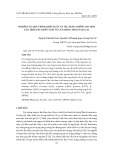

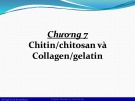


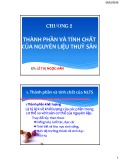

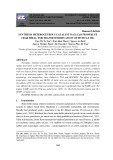
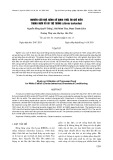

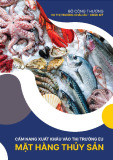


![Bài giảng Kinh tế thủy sản [mới nhất]](https://cdn.tailieu.vn/images/document/thumbnail/2025/20250808/kimphuong1001/135x160/91611754640469.jpg)

![Kỹ thuật nuôi thâm canh cá lóc trong ao đất: Tài liệu [chuẩn/mới nhất]](https://cdn.tailieu.vn/images/document/thumbnail/2025/20250724/kimphuong1001/135x160/3731753342195.jpg)




![Kỹ thuật nuôi cá nâu trong ao đất: Tài liệu [Mới nhất]](https://cdn.tailieu.vn/images/document/thumbnail/2025/20250723/vijiraiya/135x160/29781753257641.jpg)
![Kỹ thuật nuôi cá mú trong ao đất: Tài liệu [Mới nhất]](https://cdn.tailieu.vn/images/document/thumbnail/2025/20250723/vijiraiya/135x160/85681753257642.jpg)



